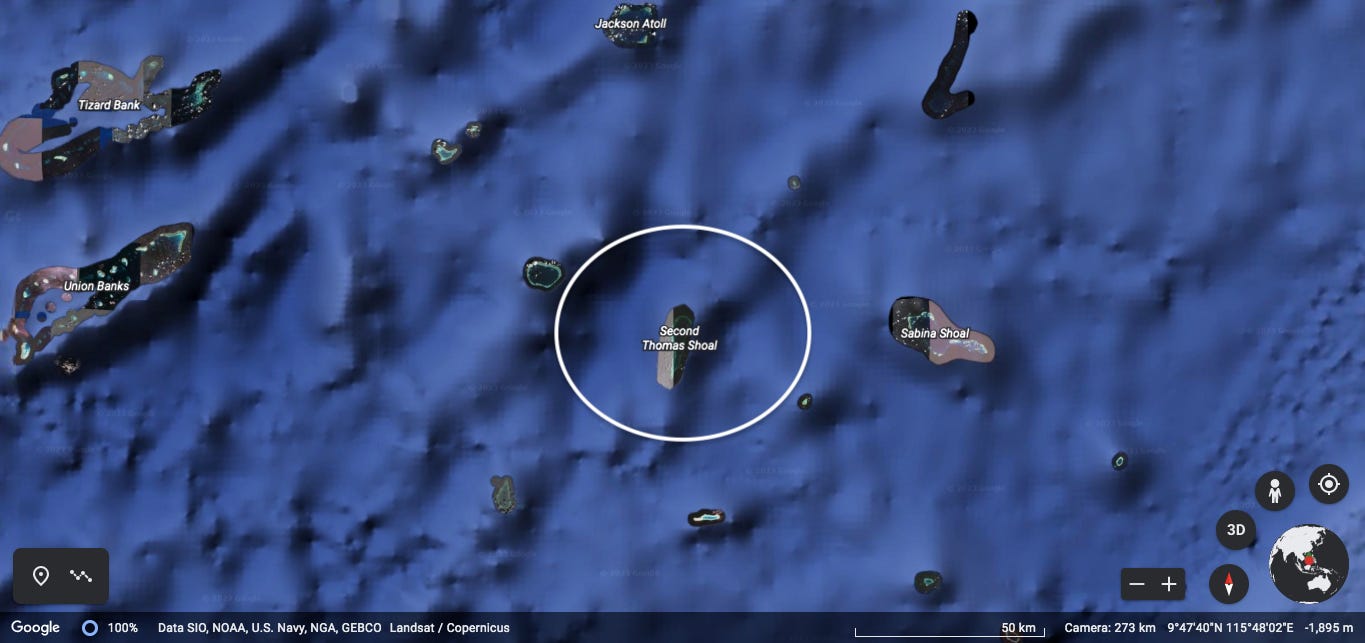Eye on China (18 February 2023)
Contents : Section A: India-China Relations; Section B: Chinese Domestic Politics; Section C: Economy and Tech; Section D: Foreign Policy Watch; E: Military Development
Section A: India-China Relations
This section is brought to you by Anushka Saxena
There have been some very interesting developments over the past few days, which are worth capturing in this week’s section.
The big story is that on 15 February, the Union Cabinet of India has given a nod to two policy decisions concerning India’s border with Tibet - the first concerns expanding the capacity of the Indo-Tibetan Border Police (ITBP), while the second concerns infusing funds into the Central Governments Vibrant Villages Programme (VVP).
First, the Cabinet Committee on Security approved a proposal to raise seven new battalions of ITBP. Briefing media in New Delhi, Information and Broadcasting Minister Anurag Singh Thakur said that the approval has also been given for the setting up of one sector headquarters of ITBP.
He also stated that 9,400 personnel will be recruited under this decision, who would be deployed in Arunachal Pradesh, where, The Hindu reports, 47 new border outposts are under construction (the completion of which will bring the total number of Indian outposts along the approximately 3,500 km-long India-China border to 176).
Anurag Thakur reportedly also said that “under this [decision], ₹1,808.15 crore non-recurring expenditure has been approved for construction of official and residential buildings, land acquisition, arms and ammunition. A recurring expenditure of ₹963.68 crore per year for the salary and ration of personnel has been approved.”
This move is significant to address any and all personnel-related gaps along the border amidst tensions surrounding the Galwan and Yangtse border clashes of 2020 and 2022 respectively. It shall also turn the ITBP into the fourth-largest Central Armed Police Force in the country, after the Central Reserve Police Force, Border Security Force and Central Industrial Security Force (as per sanctioned strengths as of 2017).
Secondly, an additional fund of ₹4,800 crore has been announced under the centrally-sponsored VVP from FY 2022-23 to FY 2025-26. The programme will reportedly cover 662 villages in the first phase, where job opportunities will be created to curb migration of the local population, and sustainable economic activities will be encouraged.
As per a PIB press release from 15 February, “the scheme aids to identify and develop the economic drivers based on local natural human and other resources of the border villages on northern border and development of growth centres on “Hub and Spoke Model” through promotion of social entrepreneurship, empowerment of youth and women through skill development and entrepreneurship, leveraging the tourism potential through promotion of local cultural, traditional knowledge and heritage and development of sustainable eco-agribusinesses on the concept of “One village-One product” through community-based organisations, Cooperatives, SHGs, NGOs etc.”.
By curbing migration and investing in all-weather physical and digital infrastructure development, the VVP clarifies its emphasis on creating a social security net for border societies. This is given the economic and military insecurities they face because of living in an isolated neighbourhood prone to threats posed by Chinese aggression.
Thirdly, the Cabinet also approved the construction of the Shinku La Tunnel to provide all-weather connectivity in Ladakh. On this front, Anurag Thakur said that the construction work of the 4.1 km tunnel would be completed by December 2025 and the total expenditure would be ₹1,681 crore.
The Minister said the tunnel would lead to all-round development of the region and give a boost to tourism, health and education sectors, and that this project was also important from a strategic and national security point of view.
The new tunnel connecting Himachal Pradesh to Zanskar Valley in Ladakh will be built by the Border Roads Organisation (BRO), as part of 'Project Yojak'.
In a tweet, Nitin Gadkari, India’s Minister for Road Transport and Highways, also laid out the use for this project:

It would be interesting to note for observers that expanding on the need to build better border infrastructure for ready availability of resources to deployed personnel, at the AeroShow recently concluded in Bengaluru, the BRO and the Innovations for Defense Excellence (iDEX, under the Ministry of Defense) have signed a Memorandum of Understanding to facilitate the development of infrastructure projects in remote border areas.
Next on the priority list of events is the announcement made by the Tibet Autonomous Region (TAR) government that it shall be investing in the expansion of its rail network, with a new rail line being built to connect Tibet and Xinjiang, and passing through the disputed Aksai-Chin.
The Hindu Reports: “By 2025, the construction of several railway projects, including the Ya’an-Nyingchi section of the Sichuan-Tibet Railway, the Shigatse-Pakhuktso section of the Xinjiang-Tibet Railway, and the Bomi-Ra’uk section of the Yunnan-Tibet Railway will all see major progress,” said a State media report quoting the plan, which was released by the TAR Development and Reform Commission.
The rail network plan for the 14th Five-Year Plan (2021-25) period and beyond released last week by the region’s Development and Reform Commission, also envisages that border railway lines will be built to Gyrong (Kyirong), a land port on the Nepal-Tibet border, and Yadong County in the Chumbi Valley, which borders India’s Sikkim and Bhutan.
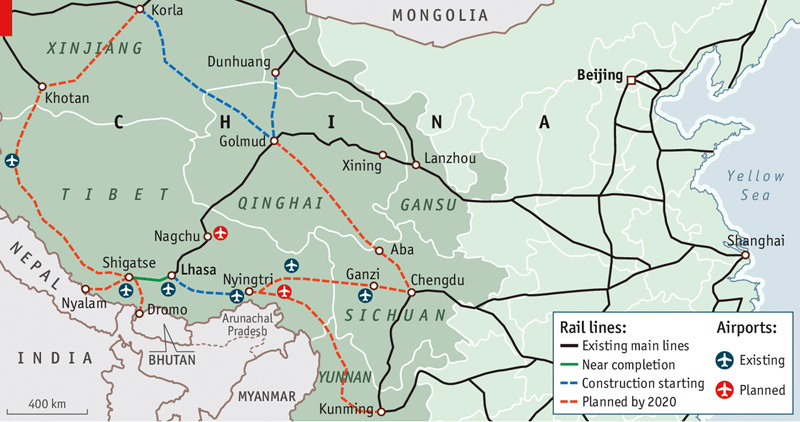
A map of existing and planned railway networks in Tibet (as of 2020) | Source: The Economist via Tibetan Review Reports confirmed this development around 13 February. Media analysts are also stating that China’s railway construction in occupied Tibet is seen as serving two purposes: first, boosting border security by enabling it to more closely integrate border regions as well as enable rapid border mobilization when needed; and second, accelerating the economic integration of Tibet with the hinterland.
It may be of interest to our readers that in December 2021, the Takshashila Institution published a Discussion Document on ‘Civilian and Military Developments in Tibet’, wherein it was argued that the Hotan-Shigatse railway under construction could pass through the Aksai-Chin region, given that Chinese sources claimed that the route would follow the G219 National Highway. In light of recent developments, you could peruse this particular document here.
Next, as the anti-China bipartisan consensus solidifies in the US Congress, Senators Merkley, Cornyn, and Hagerty of the US Senate have introduced a bill that unequivocally identifies the state of Arunachal Pradesh as an inalienable part of Indian territory, and condemns the PRC’s “expansionist” claims over it.
Also in a public show of support for India’s “defensive postures” against China’s aggression on the border, a press statement released by Senator Merkley on his Oregon government website on 16 February, reaffirmed that the United States recognizes the McMahon Line as the international boundary between the People’s Republic of China and the Indian state of Arunachal Pradesh, and that the resolution serves to further strengthen the US-India bilateral partnership regarding defense, technology, economics, and people-to-people ties.
As if in an attempt to invite Beijing’s ire on as many fronts as possible, the Press release also lauded India for “expanding its cooperation with Taiwan in public health and other sectors.”
Moreover, the Bill itself has committed to “deepening United States assistance to the region, including through the Department of State and the United States Agency for 16 International Development using funding mechanisms such as the Countering PRC Influence Fund.”
Among other such bills pending in the Senate, this bill is in line with a pattern visible in decision-making within the US Congress that is increasingly hostile towards China, and is willing to take serious military, diplomatic and economic action against Chinese aggression.
The full text of the Bill can be perused here: https://www.merkley.senate.gov/imo/media/doc/india_resolution_feb_2023.pdf.
Amitabh Kant openly critiques China’s debt-trapping strategies among developing countries
On 14 February, Bloomberg reported that Amitabh Kant, India’s sherpa during its G20 Presidency, said that “China needs to come out openly and say what their debt is and how to settle it.” He further went on to say, “It can’t be that the International Monetary Fund [IMF] takes a haircut and it goes to settle Chinese debt. How is that possible? Everybody has to take a haircut.”
The report also argued that Western lenders have already asked China to stop going solo on debt relief. While India and the Paris Club of major creditor nations are willing to forgive a certain amount of debt owed by Sri Lanka, China is only offering to extend the repayment schedule.
The Hindu reported on China’s position on the matter. It said: India and the Paris Club have emphasised the need for equitable treatment of all bilateral lenders, effectively signalling China must receive no concessions in the process.
On Beijing’s position on a possible debt reduction, Chinese Foreign Ministry spokesperson Wang Wenbin said at a daily briefing on Wednesday [15 February] that China “stands ready to work with relevant countries and [international] financial institutions to continue to play a positive role in helping Sri Lanka navigate the situation, easing its debt burden and helping it achieve sustainable development.”
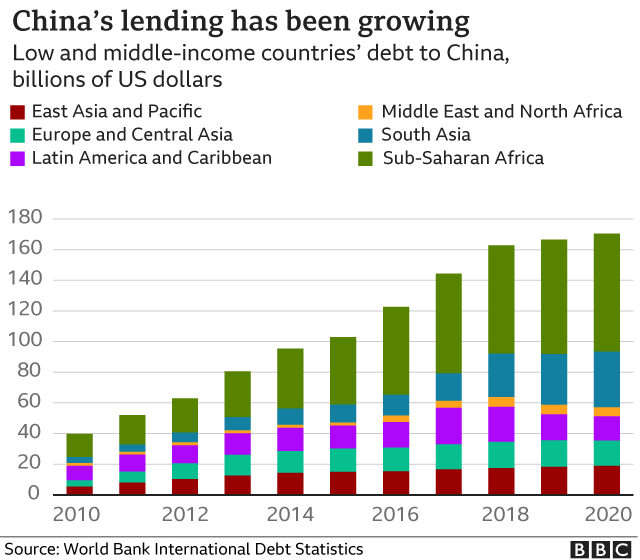
However, it remains to be seen if China will come on board by sending written financing assurances to the IMF, especially since Beijing has indicated that Sri Lanka’s multilateral loans must also be subject to a haircut.
Reiterating the position, Mr. Wang told the media that the Export-Import Bank of China will “continuously call on commercial creditors to provide debt treatment in an equally comparable manner and encourage multilateral creditors to do their utmost to make corresponding contributions.”
Section B: Chinese Domestic Politics
This section is brought to you by Amit Kumar
For this week, the following news items caught my attention in China’s domestic politics:
Senior CPC official meets Panchen Lama Rinpoche
Xinhua reports that on 17 February, Shi Taifeng, a member of the CPC Politburo who heads the United Front Work Department of the CPC Central Committee, met Panchen Rinpoche and extended Tibetan new year greetings.
Shi acknowledged the “achievements made by Panchen Rinpoche in various aspects,” and expressed “hope that Panchen Rinpoche can firmly keep in mind the earnest expectations of General Secretary Xi Jinping, and maintain a high degree of unity with the CPC Central Committee with Comrade Xi Jinping at its core ideologically, politically and in action” and “that Panchen Rinpoche can actively make a contribution to safeguarding national unity and ethnic solidarity, and advancing national rejuvenation on all fronts while delivering new achievements in upholding the principle of developing religions in the Chinese context, and advancing the adaptation of Tibetan Buddhism to the socialist society.”
Panchen Rinpoche was quoted by Xinhua as saying that “he would firmly bear in mind earnest instructions issued by the General Secretary Xi Jinping, conscientiously study and implement the guiding principles of the 20th CPC National Congress, and actively contribute to aligning Tibetan Buddhism to the Chinese context and socialist society.”
Xi’s article in Quishi Journal
The flagship journal of the CPC Central Committee, Quishi has published an article by Xi Jinping in the year’s fourth issue. The article is an excerpt from Xi’s speech that he delivered at the Central Economic Work Conference (CEWC) in December 2022.
Following are the highlights from the article:
economic work in 2023 is complicated, and it is necessary to bear in mind the overall strategic picture, focus on the major problems and start with improving public expectations and boosting confidence in development;
efforts to expand domestic demand by prioritizing the recovery and expansion of consumption, and effectively driving investment of the whole society through government investment and policy incentives;
give full play to the supporting role of exports in the economy and accelerate the transformation of China into a trader of quality;
to improve the country's resilience and the security of the industrial and supply chains
accelerate and upgrade its industrial system by planning ahead in key areas and comprehensively modernizing its industrial system, so as to consolidate its leading position in traditional advantageous industries and create new competitiveness;
continuing reforms to develop the socialist market economy, and solidly implementing the principle of unswervingly consolidating and developing the public sector while encouraging, supporting and guiding the development of the non-public sector;
deepen the reform of state-owned capital and state-owned enterprises (SOEs), while enhancing the core competitiveness of the SOEs;
to improve the development environment for private firms and promote the development and expansion of the private sector;
urges more efforts to attract and utilize foreign investment given that international competition for attracting investment is becoming more intense;
to expand market access, comprehensively improve the business environment, and provide targeted services to foreign-funded enterprises;
to effectively forestall and defuse major economic and financial risks, including the systemic risks arising from the property sector, financial risks and local government debt risks.
CPC declares ‘decisive victory’ in COVID response
The Standing Committee of the Politburo (PSC) of the CPC Central Committee in its meeting declared that “China has achieved a major and decisive victory in its COVID-19 prevention and control since November 2022,” reports Xinhua.
The meeting took note of the following that were of interest, and I think are crucial in the party’s narrative around the management of the pandemic:
The CPC Central Committee with Xi at its core always put the people and their lives first and optimized prevention and control measures in light of evolving situations
Continuous efforts to optimize COVID-19 prevention and control measures since November 2022 have led to a smooth transition in a relatively short time with the fatality rate remaining the world’s lowest
China created a miracle in human history by pulling a highly populous nation through a pandemic
The CPC Central Committee has been proven right in its judgment of the pandemic situation, major response decisions and major strategy adjustments.
The country’s robust measures received approval from the people
The meeting also called for “optimizing the medical service system, enhancing COVID-19 monitoring and early warning capacity, improving the vaccination rate among the elderly, and improving the efficacy of the vaccines in accordance with the mutation of the virus to “consolidate the hard-earned achievements in a resolute manner.”
Thoughts: Merits of the each of these claims are highly questionable, whether it is the optimization of prevention measures, people’s support, or fatality rate. The most interesting bit is the claim of being proven right in the Central Committee’s approach to COVID management, especially as both the government’s stringent restrictions and its abrupt removal became issues of severe criticism. While the restrictions under the Dynamic zero COVID policy had led to countrywide protests, the abrupt removal of restrictions led to a sharp rise in infections and fatalities across the country. SCMP reported that according to the data released by the Chinese Centre for Disease Control and Prevention, more than 80,000 COVID-19-related deaths at hospitals from December 8, 2022, to February 9, 2023, occurred in the mainland.
China issues “No. 1 Central Document” to promote rural revitalization in 2023
In the year’s first policy statement released by China’s central authorities, rural revitalization was indicated as a priority policy area. According to Xinhua, the party has released its “No.1 central document” for 2023 that outlined “nine tasks for comprehensively promoting rural vitalisation this year.”
Below are the highlights from the document:
enhanced efforts to stabilize production and ensure the supply of grain and important agricultural products,
to boost the construction of agricultural infrastructure,
to strengthen support for agricultural science, technology and equipment
to consolidate and expand the achievements of poverty alleviation,
and to promote the high-quality development of rural industries
promote the building of a beautiful and harmonious countryside that is desirable to live and work in,
to improve the rural governance system led by Party organizations,
and to strengthen policy guarantees and structural and institutional innovation.
The document seeks to put forward “specific arrangements for accelerating the building of China’s strength in agriculture.” It underlines that “the most arduous and heavy task of building a modern socialist country in all respects still lies in the countryside.”
The document talks about the global risks, challenges and uncertainties to emphasize the importance of maintaining the bedrock of “agriculture, rural areas and farmers.”
It adds that there is “no room for error” as it links agricultural development to self-sufficiency in grain supply and national security. It seeks to transform China’s permanent basic farmland into high-quality farmland, invigorate the seed industry and achieve technological breakthroughs in agriculture.
The document also looks at agricultural development as a tool for poverty alleviation and reducing the income and development gap between rich and less affluent regions.
Thoughts: It reveals the importance the party attaches to rural and countryside to unleash demand and consumption that has taken a hit lately. The dual objective is to ensure grain security and rural development that is crucial for the party’s common prosperity programme.
The SCMP reports: the “authorities plan to enact a grain-security law and deepen the nation’s import-diversification strategy, according to the document.”
The SCMP carried interesting numbers regarding China’s agricultural output: “China imported 146.9 million metric tonnes of grains – including rice, wheat and corn – last year, down 10.7 per cent from 2021. It was equivalent to 21.4 per cent of domestic production last year.”
The document is in alignment with China’s ambition to become an agricultural superpower with sufficient supplies, technological equipment, industrial resilience and competitiveness. The document underlines the effort to keep the annual grain production over 650 billion kg, and expand the acreage of soybeans and oil corps which it currently imports.
The SCMP further reports: “A new initiative has also been launched to expand grain capacity by at least 50 million metric tonnes, aiming to improve per-unit productivity through seed and technologies, and to expand farming acreage through subsidies and incentives.”
It quotes Agricultural Minister Tang Rejian as saying, “This is not a question of whether or not it can be done, but a matter that we must do. We must concentrate the necessary resources, strength and means, striving to elevate grain-production capacity to a new level as soon as possible.”
The SCMP also informs that “respective production quotas have been allocated for local governments across the country, and officials will be held accountable for failing to meet those quotas.”
Chinese pensioners take to the streets to protest health insurance cuts in Wuhan and Dalian
For the second time in the past week, hundreds of elderlies in the city of Wuhan, and now in Dalian, are protesting against medical insurance reforms introduced by local authorities that seek to cut monthly claims for medicine to one-third of the previous amount.
China’s medical insurance system funds are maintained under two categories: a collective pool and a personal medical allowance deposited in an individual’s personal account. The reform by the local authorities seeks to reduce the benefit in the second category.
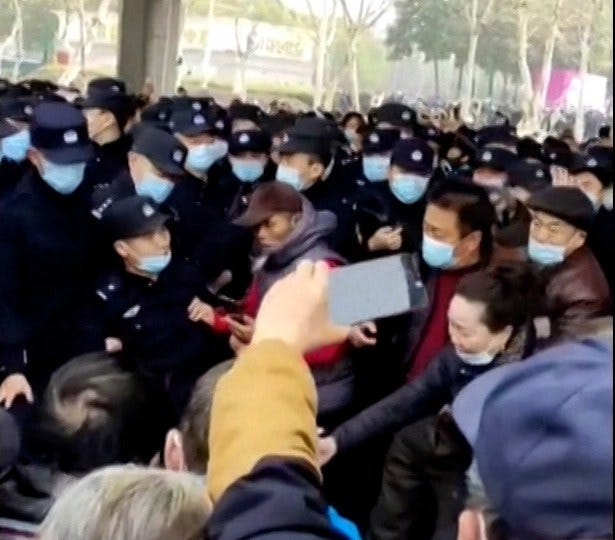
Photo of the Protests | Source: Radio Free Asia
According to The Hindu, the reform seeks to cut “medical benefit allowance for retirees, from 260 yuan per month to 83 yuan.”
Circulated videos show the crowd singing the revolutionary anthem “The Internationale” and demanding an explanation for the benefit cut.
The Washington Post reports: “The idea was to focus on essential care by increasing funds in a centralized account used for major inpatient care while reducing those available in a personal account used for outpatient services and medicines. Although the revisions are a nationwide effort, the specific approach is determined locally.”
The local authorities are reeling under financial stress and revenue crisis owing to their stretched expenditure during the Zero-COVID policy and dwindling return from the real estate sector that forms the major chunk of their revenue source. The adjustment comes as an attempt to ease pressure on state insurance funds in the backdrop of an increasingly aging population and a slowing economy.
The New York Times reports that similar protests by retirees took place in Dalian (Liaoning), Guangzhou, in addition to Wuhan.
Protests on single issues around education, pensions, property, and so on are common in China.
Section C: Economy and Tech
This section is brought to you by Amit Kumar
It’s a relatively shorter section this week, with two developments of interest:
EUCham calls on China to create a predictable business environment in Shanghai
The EU Chamber of Commerce in China (EUCham), in its position paper, has made 37 proposals to help Shanghai transform itself into a regional headquarters economy and world-leading innovation hub, reports SCMP.
It continues: Shanghai, referred to as the ‘dragon head’ of the Chinese economy is the mainland’s biggest city and its economic capital. It is highly dependent on multinational businesses for jobs and taxes. Foreign businesses account for 25% percent of the city’s GDP and their tax payments represent a third of Shanghai’s total tax revenue. Further, about one in every job in the city is provided by a foreign employer.
The report identified the difficult visa regime, soaring negative perceptions, and pandemic-induced restrictions as issues to be rectified. Shanghai’s stringent restriction amid the COVID breakout last year led to its economy shrinking by 13.7% in the second quarter, making it the worst slowdown in four decades. It noted that 92% of the EUCham’s members in Shanghai reported severe supply-chain disruptions.
The Chamber said that China will have to implement measures “to demonstrate that the Chinese market is reliable, predictable and efficient, important facets that have all been eroded over the past three years” and address the “current lack of level playing field for all market players and the politicization of business.”
In a related report, SCMP refers to the Supply Chain Stability Index by KPMG, a global accounting firm that noted that “operations up the end of 2022 were “slightly more stable” but “hasn’t returned to the pre-pandemic level yet” and “still relatively unstable overall.” and termed the situation “more fragile than before.”
The report also quotes the McKinsey Global Institute’s paper, which emphasised that while China is the net exporter of electronics, basic metals and chemicals, it also relies on net imports for intellectual property and all mineral resources, to underline that “no region is close to being self-sufficient.”
While the easing of COVID restrictions in China has led to optimism among foreign investors about business prospects but concerns surrounding geopolitical tensions, protectionism, regulatory uncertainty, and emphasis on diversification have also made them cautious, reports SCMP. According to US-China Business Council’s survey, 87% reported “business impacts” from China-US tensions.
China to grant zero-tariff treatment to Ethiopia, Burundi, Niger
Xinhua has reported that according to the statement released by the Customs Tariff Commission of the State Council, “China will grant zero-tariff treatment to 98% of taxable items originating from Ethiopia, Burundi and Niger from March 1, 2023.”
It further states: “The new step is conducive to materializing the spirit of China-Africa friendship and cooperation, helping the least developed countries accelerate their development, building an open global economy.”
The Council plans to gradually expand such treatment to all the least developed countries that have established diplomatic ties with China, the report added.
Section D: Foreign Policy Watch
This section is brought to you by Kingshuk Saha and Anushka Saxena
There have been some very interesting developments over the past few days, which are worth capturing in this week’s section.
Iranian President Ebrahim Raisi Visits China
Iranian President Ebrahim Raisi arrived in China on Tuesday, 14 February, for a three-day state visit.
Iran’s Foreign Ministry spokesman Nasser Kanaani said, “The visit is particularly important from a political perspective. It indicates the existence of a proper political atmosphere in relations and emphasizes the highest political atmosphere in relations and emphasizes the highest political will from the leaders of the two countries to expand bilateral ties based on mutual interest”.”
CGTN’s report of the visit quoted Xi as saying, “China supports Iran's stance in protecting its sovereignty and territorial integrity, and that any confrontation should be resolved through dialogue and negotiation.”
Reportedly, the meetings between Xi and Raisi were heavy on a mutual critique of the west, and solidarity on the principle of ‘non-interference’.
This is the first visit of an Iranian President to China in the last two decades years. It is taking place in the backdrop of a domestic crisis in Iran, and an increasing international ostracization that is taking a toll on the country’s already fragile economy.
Wang Yi’s European Tour
Wang Yi, Director of the CPC Central Foreign Affairs Commission, will be undertaking a trip to Europe from February 14 to 22, during which he is visiting France, Italy, Hungary and Russia, and is also reported to be attending the 59th Munich Security Conference.
The trip started off in Paris with Wang Yi co-chairing the 23rd China-France Strategic Dialogue with Emmanuel Bonne, diplomatic counselor to French President Emmanuel Macron.
The Dialogue was significant as it affirmed the commitment of the two sides towards expanding international cooperation on key issues of mutual importance, while Bonne reportedly even expressed France’s willingness to actively participate in the 2023 Belt and Road Forum for International Cooperation.
Wang's visits come at a time when the tensions in the US-China relationship are rising over the shooting down of a suspected Chinese spy balloon over the US. There is also a fraying of relations between China and the EU.
The visit aims to restore ties with the European nations. However, Andrew Korybko, a political analyst based in Moscow, said “Wang would have to work hard to reassure the European Union of China’s peaceful rise during his trip”.
This is especially true, given that Wang Yi is also visiting Russia, and has only affirmed plans to strengthen the Russia-China partnership. According to China’s Foreign Ministry spokesman, Wang’s visit to Moscow will provide an opportunity for China and Russia to continue to develop their strategic partnership and “exchange views” on “international and regional hotspot issues of shared interest.”
China’s unwillingness and strategic inability to take a firm stance against the war in Ukraine has deepened the mistrust between itself and Europe.
China slaps sanctions on Lockheed Martin and Raytheon over arms sales to Taiwan
On 16 February, China imposed sanctions on major U.S. armament companies Lockheed Martin and Raytheon for selling arms to Taiwan.
Lockheed Martin has supplied Taiwan’s armed forces with fighter jets, radar and navy frigates, while Raytheon has aided the upgrade of Taiwan's military radar systems.

A list of defense equipment programmes Lockheed Martin runs in Taiwan | Source: Lockheed Martin’s ‘Taiwan’ Webpage
China’s Ministry of Commerce (MOFCOM) in a statement said, that it has taken a slew of action against the two companies, including banning them from conducting any business activities in China or making new investments in China.
Officials of the two companies will be denied entry into China as well, while work and residency permits for senior officials will be revoked or not granted.
These sanctions seem to be a response to the shooting down of the alleged Chinese spy balloon by the U.S. using the F-22 Raptor fighter jet made by Lockheed Martin.
What would be interesting to observe is how China would enforce the sanctions as the U.S. doesn’t sell arms to China nor do these companies have offices in China.
White House press secretary Karine Jean-Pierre said “These are symbolic measures and unnecessary - that's how we view them.”
On 17 February, Chen Xu, Permanent Representative of China to the United Nations Office in Geneva and head of a delegation at the periodic review meeting of the UN Committee on Economic, Social and Cultural Rights, defended questions from Committee exports on forced labour against Uyghur Muslim Minorities and Tibetans.
In its usual tone, the delegation said that “the vocational training center in Xinjiang Autonomous Region was not a detention center or a place for forced labour. It was a school that de-radicalized trainees. It educated persons that had taken part in minor terrorist activities that did not constitute crimes.”
The questions of China not sharing information on COVID-19 in a timely manner, and other human rights abuses in Hong Kong, also came up at the meeting. On COVID-19, a health official, He Qinghua, again in the usually adopted tone and words, said China's cooperation with the World Health Organization and other governments was “open and transparent, and the cooperation is also effective.”
On Hong Kong, a representative from the delegation made the controversial and yet unsurprising remark that “Basic human rights and freedoms were recognized under the Hong Kong Special Administrative Region Basic Law; however, rights and freedoms were not absolute and could be restricted.”
The readout and reports of the Committee session are available here, if it interests you: https://www.ohchr.org/en/news/2023/02/committee-economic-social-and-cultural-rights-commends-china-efforts-reduce-poverty.
C+C5 Industry and Investment Cooperation Forum kicks off
On 16 February, China and the five Central Asian Republics of Kazakhstan, Kyrgyzstan, Tajikistan, Uzbekistan and Turkmenistan (C+C5) inaugurated the first-ever forum on industry and investment cooperation at Qingdao in East China's Shandong Province.
Xi Jinping also sent a congratulatory letter to the (C+C5) industry and investment cooperation forum, lauding the strategic partnerships between China and the five countries of Central Asia, which have established a new path with a friendly neighborhood and win-win cooperation and a new paradigm for international relations, the Xinhua News Agency reported.
He Lifeng, head of the National Development and Reform Commission, which organized the forum along with the provincial government of Shandong, said at the forum via video link that President Xi's congratulatory letter reflects the great importance attached to the forum.
The two-day forum was attended by 300 representatives from embassies of the five Central Asian countries, and Chinese and foreign businesses, and vice prime ministers of the five Central Asian countries addressed the forum via video link.
International Organization for Mediation Prep Office opens in Hong Kong
Interestingly, China has taken it upon itself to run a platform for the resolution of intergovernmental disputes at a global stage, by inaugurating a Preparatory Office for an ‘International Organization for Mediation’ (IOMed) in Hong Kong Central on 16 February.
During the inauguration ceremony, Qin Gang (Chinese Foreign Ministry), made televised remarks, in which he laid out the vision for the Organization, stating that “It will transcend the limit of litigation and arbitration, Qin said, calling for jointly building an authoritative, trustworthy, efficient and professional international mediation institution.”
Wang Yi also wrote a letter to be read out at the ceremony, which reportedly detailed that at least nine countries – Indonesia, Pakistan, Laos, Cambodia, Serbia, Belarus, Sudan, Algeria and Djibouti – had signed a joint statement supporting and agreeing to take part in the IOMed.
The establishment of the Organization in Hong Kong, apart from carrying the symbolic value of leveraging its common law heritage and expertise as a dispute resolution centre, also affirms China’s ‘One Country, Two Systems’ dynamic with it, signifying that even though the IOMed is based in Hong Kong, it is administratively under the control of FMPRC.
Section E: Military Developments in China
This section is brought to you by Anushka Saxena
This week, the following developments concerning the Chinese military and police force, have grabbed my attention :
The big story is that in a statement released on 13 February, the Philippine Coast Guard (PCG) said the crew of its ship, the Malapascua, encountered the Chinese coastguard vessel on February 6 as they were about 10 nautical miles (18.5 km) from Ayungin Shoal (local), also known as Second Thomas Shoal, during a routine resupply trip to sailors stationed there.
He stressed that the move of the Chinese Coast Guard to point a weapons-grade laser light, which the PCG claimed caused “temporary blindness” to the vessel’s crew, was a professional and restrained way to uphold China’s sovereignty and maritime order.
China claims the Second Thomas Shoal as its own, while the Philippines landed its ship, Sierra Madre on the shoal in 1999, after it was destroyed during the second world war. This was done to indicate Philippine ownership over the shoal.
The flare-up of tensions in the South China Sea was imminent, given that the US announced earlier this month that it has secured a deal with the Philippines to gain access to four of its military bases, in a bid to keep China in check in case of a South China Sea or a Taiwan contingency.
Moreover, on the day of the ‘laser attack’, Reuters also published an interview with Commandant of the PCG, who was quoted as saying, "We're making sure that the presence of coast guard vessels is felt by the fishermen in the area.” This meant deploying an increased number of vessels, and conducting more sorties in the disputed region.

The PCG statement also clarified that “Regardless of this challenging situation, the PCG remains steadfast in protecting the sovereignty and rights of the country and Filipinos in the West Philippine Sea.”
In Beijing, Chinese Foreign Ministry spokesperson Wang Wenbin reportedly said a Philippine coast guard vessel trespassed into Chinese waters without permission on February 6. Chinese coast guard vessels responded “professionally and with restraint at the site in accordance with China’s law and international law,” he said, without elaborating and mentioning the use of laser.
In the aftermath, on 14 February, Philippine President Bongbong Marcos also summoned Chinese ambassador to the Philippines, Huang Xilian, “to express his serious concern over the increasing frequency and intensity of actions by China against the Philippine Coast Guard and our Filipino fishermen in their bancas.”
The Philippine Department of Foreign Affairs (DFA), meanwhile, also announced that it has filed a diplomatic protest against China. To read more on this, please refer to Philippine Star’s coverage on the matter:


Yet again, at a conference hosted by the Brookings Institution in Washington DC on 13 February 2023, another Pentagon official affirmed that American defense officials believe a Chinese invasion of Taiwan is “neither imminent nor inevitable.” This time, it was the US Air Force Chief of Staff, General Charles Brown.
He added, “I’ve been disappointed by some of the comments that have been made [about conflict time frames] because it takes away from what we’re really trying to do, which is to make sure we’re going to be ready.”
On 11 January 2023, US Secretary of Defense Lloyd Austin also made a similar statement, that “a Chinese invasion of Taiwan was not imminent.”
A while ago, I wrote an analysis on the matter, titled “Taiwan Strait: Are US-China gambling or guardrailing?.” Please do read if it interests you: https://www.firstpost.com/opinion/taiwan-strait-are-us-china-gambling-or-guardrailing-12061212.html.
Next, an article appearing in the PLA Daily on 14 February discussed details of a combat training exercise conducted by Karakoram, a division of the Xinjiang Military region, in “early spring” (no date specified).
Attack drones were used to practice combat in a plateau region.
It is interesting to note that this particular article highlights how the plateau exercise failed due to poor communication and coordination between the ground and air forces.
It quoted the party committee of the division saying, “Only by organically integrating various combat elements, combat forces, and combat units to improve synergy can truly form a land-air joint force.”
The acknowledgment that despite the adoption of various elements of modern warfare across combat units and services, “true integration” hadn’t fully been achieved, was looming large.
Another interesting observation made in the article was that “During the exercise, the battle became fierce, and many hidden firepower points of the "enemy" were stubbornly resisting, and the attack of the division's front attack unit was blocked. In the command post, the ground and air staff members jointly studied the "enemy situation", and a staff officer of the division proposed to call the air force to carry out precise strikes on the "enemy" firepower points.”
However, the strategy was apparently objected to by “a staff officer from a certain Air Force department,” as he called instead for the use of firepower from ground forces to deal with the “enemy” in complex terrain. This suggestion was ultimately adopted by the Commander and the “target was successfully destroyed.”
This knowledge of PLA training methodology, of techniques of cooperation and coordination both, between units and between forces in Command Control versus on the ground, and of mental models of adaption to “destroy the enemy,” can be helpful to military observers and practitioners alike.
On the political front, another article published in the PLA Daily on 13 February detailed the contents of a “Notice on Comprehensively Carrying out Military Administrative Litigation Work” issued by the Political and Legal Committee of the Central Military Commission.
The “Notice” requires that the political and legal committees of party committees at all levels should earnestly take military administrative litigation work as an important starting point for implementing the strategy of governing the army according to law, strengthening work guidance and overall coordination, solving difficult problems in a timely manner, and strictly implementing the “three regulations” to prevent judicial interference, to support and guarantee military courts to fully perform their duties.
The Three regulations refer to three orders signed and issued by Xi Jinping with effect from 1 May, 2018, regarding the military’s “interior order, code of conduct and military formation.” Revisions made in the regulation of the military code of conduct, for example, gave a greater emphasis to political loyalty to the CPC in general and Xi in specific, which is also strengthened by the abovementioned idea that military courts should have full rights over how well ideology is followed and implement among armed officers. Similarly, revisions in the “interior order” regulation also focused on enhancing the political loyalty of the armed forces.
Other things the revised regulations focus on include rules on military discipline, training management, soldiers’ weight standards, their use of mobile phones and the Internet, as well as elements as specific as the use of gun-firing salutes to pay respect to martyrs.
It is interesting that the “Notice” says “prevent judicial interference,” even though China’s military court is under the dual leadership of the civilian Supreme People’s Court and the Political and Legal Committee of the CMC.
The “Notice” apparently also extolls the need for the full implementation of the spirit of ‘Xi’s New Era of Socialism with Chinese Characteristics’ in comprehensive reform and development of military administrative legislation work.
That is not all on the military-political loyalty front. On 13 February itself, the General Office of the CMC apparently also issued a ‘Study and Education Plan for the Chairman Responsibility System (CRS) of the Military Commission’.
As usual, the ‘Plan’ “fully implements the spirit of the 20th National Congress of the Communist Party of China, thoroughly implements Xi Jinping’s thought on strengthening the military, and clarifies the overall requirements, basic content, key tasks and organizational guarantees for in-depth study and education of the chairman responsibility system of the Military Commission.”
Correlated but equally significant “virtues” highlighted therein include that the military officers are required “to be absolutely loyal, absolutely pure, and absolutely reliable, and to obey the Party Central Committee in all actions, the Central Military Commission and Chairman Xi’s command.”
In Xi’s own words, “the chairman responsibility system of the Military Commission is the fundamental system and fundamental implementation form for upholding the party's absolute leadership over the people's army, and it is the "spirit of the sea" to ensure that the soul of the army will be stationed forever and the Great Wall will be forever.”
At its 19th National Party Congress in October 2017, the CPC decided to enshrine in the CPC Constitution that “Chairperson of the Central Military Commission assumes overall responsibility over the work of the commission.” Before that, in November 2012, revisions made to the CMC Working Rules also stated that the CMC must thoroughly implement the CRS, replacing the idea that the Vice-Chairmen took the lead of the overall and day-to-day affairs of the CMC and the military forces, as was the case under Hu Jintao and Jiang Zemin.
Then, on 16 February, PLA Navy Spokesperson Senior Captain Liu Wensheng announced that the Chinese 052D-type guided-missile destroyer ship ‘Nanning’ will participate in NAVDEX, a naval defense and maritime security exhibition being organized in the United Arab Emirates from 17-25 February, 2023.
After being part of the 43rd Naval escort taskforce sent by China to the gulf of Aden, and then participating in Pakistan’s naval exercise AMAN (Peace)-23 only recently, the Nanning is now being deployed for the naval show in UAE.
We did a brief coverage on details about the Nanning and its deployment to the Pakistan naval exercise in the previous edition of ‘Eye on China’. Please do peruse:
Finally, vis-a-vis other usual engagements of Chinese forces abroad, on 11 February, the 21st Chinese peacekeeping multi-role engineering company participated in the Exercise Tiger 2023 held by the United Nations Interim Force in Lebanon (UNIFIL), which took place at the barracks of the company in the south Lebanese village of Hinnieh.
The exercise aimed at improving emergency evacuation, family assistance, camp defense and armed escort for the UNIFIL.
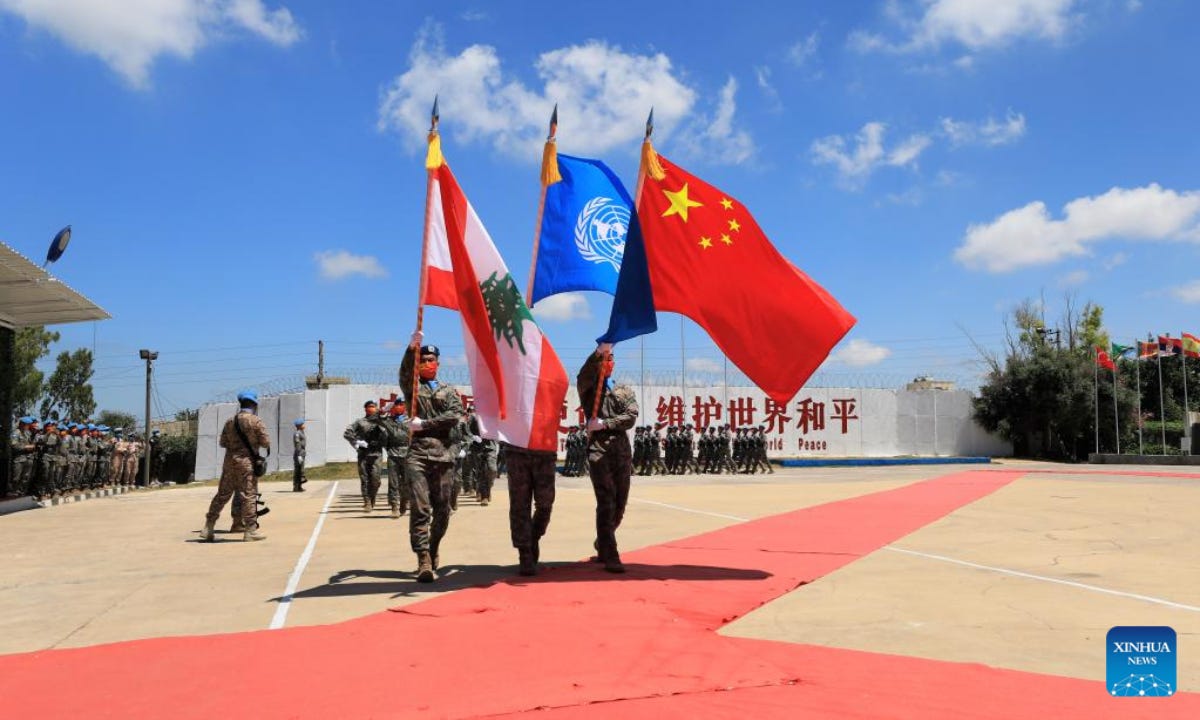
An image from the Medal Awarding ceremony for Chinese peacekeepers in Lebanon, 2 July 2022 | Source: Xinhua The 21st Chinese peacekeeping multirole engineering company participated with 60 peacekeepers and 20 civilian officers from various countries.
The crux of the exercise was to be able to evacuate and safely put up in camps for any and all UNIFIL staff and/or civilians in a war-torn situation. Providing them with food and medical assistance was also a practice point.
To read more on developments concerning Chinese military forces, please refer to :
Spacebattles (a more informal channel for public discussions)
Eye on China is a weekly newsletter curated by the Indo-Pacific Studies Programme at The Takshashila Institution, a public policy think-tank based out of Bengaluru, India.
Contributors :
India-China Relations: Anushka Saxena (with help from Amit Kumar)
Chinese Domestic Politics: Amit Kumar
Economy and Tech: Amit Kumar
Foreign Policy Watch: Kingshuk Saha and Anushka Saxena
Military Developments in China: Anushka Saxena






